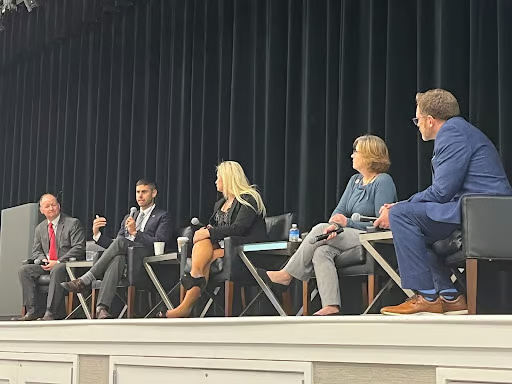Lawmakers discuss child care challenges, solutions during Iowa Women’s Foundation’s Solutions Summit

BY MICHAEL CRUMB, BUSINESS RECORD SENIOR STAFF WRITER
While progress has been made in increasing the availability of quality, affordable child care in recent years, more needs to be done, state lawmakers said in a recent panel discussion during a forum on challenges facing child care providers in Iowa.
The discussion occurred during the Iowa Women’s Foundation’s first Iowa Solutions Summit focused on child care and solutions to solving the state’s child care shortage. The summit was held Dec. 6 at Prairie Meadows in Altoona. Participating in the panel discussion were Rep. Heather Matson, D-Ankeny; Rep. Megan Jones, R-Sioux Rapids; Sen. Jeff Edler, R-State Center; and Sen. Nate Boulton, D-Des Moines.
The forum was moderated by former television news reporter and political analyst Dave Price.
During the conversation, lawmakers discussed challenges the industry is facing, efforts to increase wages for child care workers, and elevating the job to a quality career rather than a low-paying, entry-level position.
Here are highlights of the discussion:
Past action that is beginning to reap benefits
Matson: “The continued investment in the [TEACH Early Childhood Scholarship Program] and the [Child Care Wages Salary Supplement Program] has had really great effects and it is evidence based and it is really great for helping the actual workforce get more skills. This is a low-wage profession and it shouldn’t be, because it is incredibly hard work, so the more we can continue to invest in it as the real profession it is, that is a big part of the recruitment and retention, so I would say continue to invest in the work we have done to invest in those programs.”
Jones: “It’s grants. The folks back home know what they need and how best to use that financing. The Spencer YMCA [was] able to access those funds and up their hourly pay to their employees a couple of dollars an hour, and that’s game-changing for some of these [people]. Some of those folks who are probably borderline needing state assistance for child care themselves, we were able to bump that up a little bit. Our child care providers know what they need and how best to utilize those funds, so if we can give them a little injection so they can take care of their short-term or long-term goals, we have to do that.”
Matson said challenges in larger communities aren’t so much about access as they are about cost and workforce retention.
Boulton: “I would say increasing eligibility for child care assistance has been a big deal. I think we have to go further than that. We are at 160% of the federal poverty level right now, which is a help from raising it from 145%. I had a proposal, we voted on it and it didn’t get passed, to do 200%. I think there is a definite need at 200% level to get accessibility for child care for those families. If we have more people being able to choose to have child care and a career and advance that, that’s good for both ends of it. By increasing that, it’s a pretty minimal investment to be a huge change for Iowa families and a really good positive impact economically for our state as well.”
Edler: “I don’t feel there is one right answer. This is such a broad-spectrum approach to a very large challenge. I think we worked collaboratively in the Legislature the last three years, especially to come up with the best way we can maximize Iowa taxpayer dollars to help them help the communities they live in provide the child care resources they need. We need to make sure we have that collaborative approach between the public and private sector. If a large business comes in and needs employees to have child care, let’s have them help do that. That brings buy-in to the community. I would also say it would be really nice if we could get some help out of federal partners to help alleviate what we want to call that cliff effect.”
Areas to build on?
Boulton: “I would say getting back to what I would call the Band-Aid that was put on the problem and the staffing ratio equation, and not using that as a permanent solution. We don’t have to be comfortable and make that the new standard moving forward. We want more people engaged in this profession long term, and that should have been a temporary solution and should not be viewed as a permanent one.”
Jones: “Every administrative rule is being released, rewritten and readopted. There has to be some easy fixes that we can help to eliminate some of the red tape [child care providers] are faced with and comply with. We need high-quality child care. The kids deserve it. The families deserve it. But we need to look at some of those they’re having to deal with, the red tape, the paperwork, the reports. It’s going to take some time because it’s a lot of work, but we need to make sure that those rules are working and that they’re there for a reason and that they are keeping kids safe.”
Matson: “I think one of the things that we can build on is a pilot project that passed last session that if you are a child care provider, staff in a child care facility, and they have kids that are child care age, then you automatically qualify for child care assistance. I’m hopeful that we’ll see some good progress on that and then be able … [to] expand upon it.”
Edler: “I would go back to the federal partnerships. Because in certain areas, there’s a disincentive for families to make more money. The way the system is set up, once they hit a certain level, the system goes away or diminishes quickly. One of the biggest things is making sure we have systems that allow for individual Iowans to progress.”
Other thoughts
Boulton: “It’s just not a solution to say more teenagers need to enter the workforce to address a workforce crisis. [The] solution to make this work better … is through grant programming, it’s through being able to provide the support as needed for child care businesses to be successful, and for people to be able to make true careers out of being child care providers.”
Edler: He said child care providers need to continue to provide information to lawmakers about their needs. “It’s all a collaboration. As I’m trying to gather that information and understand in different regions what specifically they need, and being able to tie into those as an employer or child care facility, is essential.”
Jones: “Sometimes government isn’t the solution to the problem, and a lot of times it’s not right. We’re always happy to help, but a lot of times, the best ideas are internal. There are a lot of organizations that come to us with great ideas and are able to do that without us passing a law and mandating it and putting the heavy hand of government coming down on folks.”
Matson: “There have been so many good pieces of legislation that have passed over the last several years, but I think we can agree that none of them are really paradigm shifting. There are some good things along the edges that helped make progress, but we wouldn’t still be sitting here talking about a workforce crisis when it comes to child care if they were really big things that were fundamentally changing where we are as a state.”

